

AAB biome activity. Exploring Biomes in Gorongosa National Park. Biomes of the World. What's a Biome?
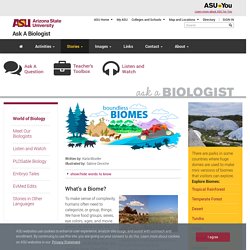
Here we see two different biomes—deserts on the left and grasslands on the right. But both are land environments. Images by Bob Protus and Bkell. To make sense of complexity, humans often need to categorize, or group, things. We have food groups, sexes, eye colors, ages, and movie genres, to name a few. The natural world is more varied than we can imagine, and one way to try to make this variation easier to handle is to put different environment types into groups.
Usually we group the different natural areas on Earth into categories based on plant and animal life and how they are able to survive in that part of the world. This biome map shows both land (terrestrial) and water (aquatic) based habitat types. A biome is a type of environment that is defined by the types of organisms that live there. Biome vs. Biome categories can be broad or narrow. These are all types of forests, but some people split them into different forest-type biomes. How Different is Different? Desert. SISD: Instructional Resources - Science - Biology/Biomes. Biology/Biomes Amazon: the World's Largest Rainforest This is a well-researched and detailed site about the Amazon Rainforest, with a significant emphasis on conservation.
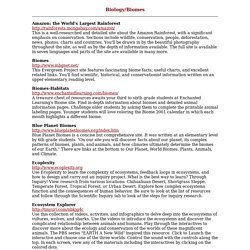
Sections include wildlife, conservation, people, deforestation, news, photos, charts and countries. You'll be drawn in by the beautiful photography throughout the site, as well as by the depth of information available. The full site is available in seven languages and parts of the site are available in many more. Biomes This Evergreen Project site features fascinating biome facts, useful charts, and excellent related links.
Biomes-Habitats A treasure chest of resources awaits your third to sixth grade students at Enchanted Learning's Biome site. Blue Planet Biomes Blue Planet Biomes is a concise but comprehensive site. Ecoplexity Use Ecoplexity to learn the complexity of ecosystems, feedback loops in ecosystems, and how to design and carry out an inquiry project. Teach21 Project Based Learning. 21C.O.5-8.1.LS1 - Student, when presented with a problem, identifies the information needed, uses text, people, online databases and search engines to filter relevant information efficiently, analyzes information for biases, synthesizes information gathered and creates an effective and efficient response to the problem. 21C.O.5-8.1.LS3 - Student presents thoughts, ideas, and conceptual understanding efficiently, accurately and in a compelling manner and enhances the oral or written presentation through the use of technology. 21C.O.5-8.1.TT4 - Student uses audio, video, pictures, clip art, moviemaker programs, webpage design software, electronic documents, and other files to create and publish electronic products to communicate with various audiences inside and outside the classroom. 21C.O.5-8.1.TT5 - Student uses advanced features and utilities of word processing software (e.g., bullets, numbering, tables, find and replace, thesaurus, help menus and toolbars).
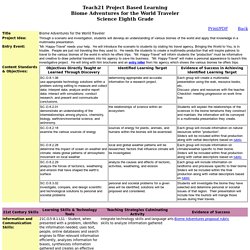
Blue Planet Biomes - World Biomes. What is a Biome?
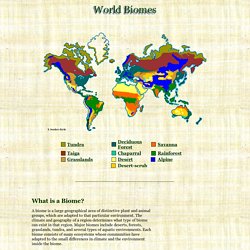
A biome is a large geographical area of distinctive plant and animal groups, which are adapted to that particular environment. The climate and geography of a region determines what type of biome can exist in that region. The world's biomes. Online exhibits The world's biomes Biomes are defined as "the world's major communities, classified according to the predominant vegetation and characterized by adaptations of organisms to that particular environment" (Campbell 1996).
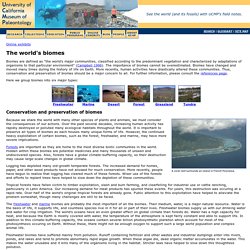
The importance of biomes cannot be overestimated. Biomes have changed and moved many times during the history of life on Earth. More recently, human activities have drastically altered these communities. Here we group biomes into six major types: Conservation and preservation of biomes Because we share the world with many other species of plants and animals, we must consider the consequences of our actions. Forests are important as they are home to the most diverse biotic communties in the world. Logging has depleted many old-growth temperate forests. Tropical forests have fallen victim to timber exploitation, slash and burn farming, and clearfelling for industrial use or cattle ranching, particularly in Latin America. The World's Biomes.